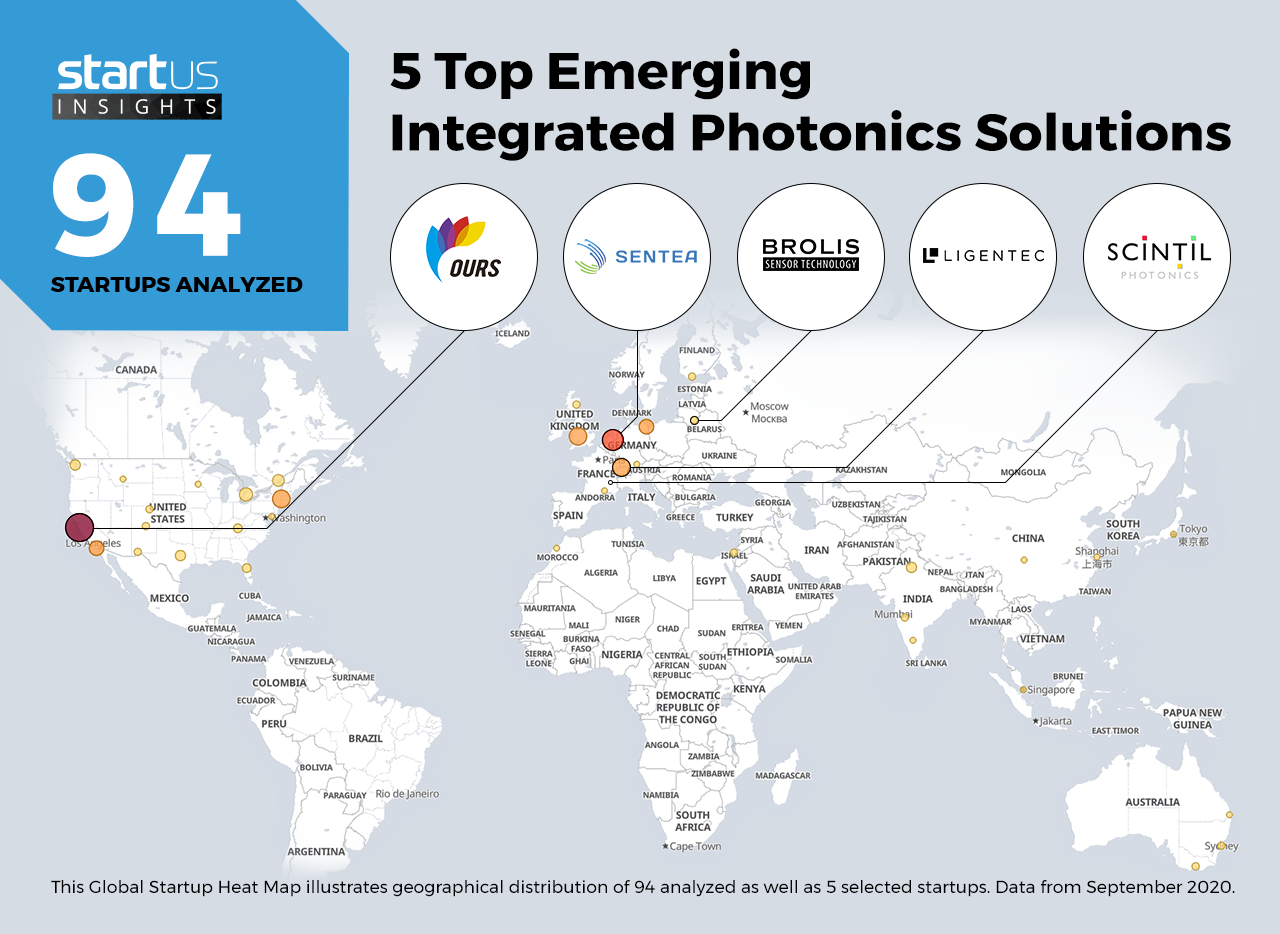Our Innovation Analysts recently looked into emerging technologies and up-and-coming startups working on solutions for the engineering sector. As there is a large number of startups working on a wide variety of solutions, we want to share our insights with you. This time, we are taking a look at 5 promising integrated photonics solutions.
Heat Map: 5 Top Emerging Integrated Photonics Solutions
Using our StartUs Insights Discovery Platform, covering 1.379.000+ startups & scaleups globally, we looked at innovation in the field of integrated photonics. For this research, we identified 94 relevant solutions and picked 5 to showcase below. These companies are chosen based on a data-driven startup scouting approach, taking into account factors such as location, founding year, and relevance of technology, among others. Depending on your specific criteria, the top picks might look entirely different.
The Global Startup Heat Map below highlights 5 startups & scaleups developing innovative integrated photonics solutions. Moreover, the Heat Map reveals regions that observe a high startup activity and illustrates the geographic distribution of all 94 companies we analyzed for this specific topic.
SCINTIL Photonics – Silicon Photonics
Silicon photonics use silicon as an optical medium and need less energy to transmit data faster compared to other communication technologies. Since silicon photonics use optical rays for data transfer, they commonly find applications in solutions that have both optical and computational functions. Startups are working to bring down the cost of integrating optical components on chips to advance the wider adoption of silicon photonics.
French startup SCINTIL Photonics develops silicon photonic integrated circuits (PIC) for applications in communications, 3D sensing, and quantum photonics. The startup’s solution, Backside-on-BOX, combines silicon and indium phosphide for the seamless integration of active and passive optical components. This enables high-coupling efficiency, on-chip optical amplification, as well as intrinsic hermetic design, and a compact form-factor.
LIGENTEC – Low-Loss Integrated Photonics
A major disadvantage of integrated photonics is the relatively lossy waveguides. Startups are modifying silicon-based solutions or interfacing them with other materials to improve the bandgap, thereby reducing losses in transmission. Silicon nitride provides an ultrawide transparency window as well as ultra-thick waveguides to minimize losses in integrated photonics applications.
Swiss startup LIGENTEC manufactures photonic integrated circuits for various applications, including quantum technologies and biosensors. The solution features an all-nitride core that reduces bending and propagation losses. For biosensing applications, the solution enables the capture of microscopy images with a field of view of hundreds of microns and nanometer-scale resolution.
Optical Universal RISC Systems – Light Detection & Ranging (LiDAR)
LiDAR technology uses focused light beams to generate a representation of the environment. LiDAR calculates distances with great accuracy and finds applications ranging from aerial inspection and crop mapping to autonomous vehicles. Startups are innovating to bring together the latest developments in LiDAR in a single chip to make the technology more affordable.
OURS, short for Optical Universal RISC Systems, is a US-based startup that develops solid-state sensing systems. Their solution combines solid-state beam-steering and coherent transceivers in a single integrated photonic chip. This chip uses frequency-modulated continuous-wave technology (FMCW) to produce high-resolution 5D point clouds. OURS’ 5D LiDAR is immune to interference from sunlight or other LiDAR sources.
Brolis Sensor Technology – Photonic Microsensors
Medical diagnostics startups usually use light-based solutions such as spectroscopy, microscopy, or visual inspection to generate their results. By combining light detection with signal processing in a single device, integrated photonics-based solutions enable rapid and highly sensitive detection of biomolecules. Moreover, the benefits of photonic microsensors include miniaturization, amenability to multiplexing, and low-cost mass production.
Lithuanian startup Brolis Sensor Technology develops next-generation photonic microsensors. Their solution uses laser-based integrated sensor technology to detect multi-molecule analytes in blood. The sensor performs an on-chip spectroscopic analysis of the reflected light to determine the concentration of analytes such as glucose, lactates, and ethanol.
SENTEA – Fiber Optic Sensor
Optical interrogators use fibers to monitor industrial assets via a network of sensors in real-time. However, optical fibers are prohibitively expensive and hard to maintain, limiting their use to high-end applications or extremely crucial operations. As integrated photonics-based solutions lower the cost of interrogators, they are expanding the scope of fiber optic sensors to new markets.
Belgian startup SENTEA is a manufacturer of fiber optic sensors. These enable highly accurate, robust, and continuous sensing of structural health to prevent equipment failure and structural damage. In addition to structural health monitoring, the solution finds applications in the monitoring of bearings and wind turbines.
What About The Other 89 Solutions?
While we believe data is key to creating insights it can be easy to be overwhelmed by it. Our ambition is to create a comprehensive overview and provide actionable innovation intelligence and enable you to achieve your goals faster. The 5 integrated photonics solutions showcased above are promising examples out of 94 we analyzed for this article. To identify the most relevant solutions based on your specific criteria, get in touch.










